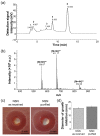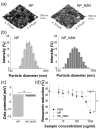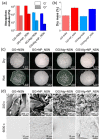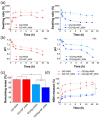Composites Based on Gellan Gum, Alginate and Nisin-Enriched Lipid Nanoparticles for the Treatment of Infected Wounds
- PMID: 35008746
- PMCID: PMC8745171
- DOI: 10.3390/ijms23010321
Composites Based on Gellan Gum, Alginate and Nisin-Enriched Lipid Nanoparticles for the Treatment of Infected Wounds
Abstract
Due to growing antimicrobial resistance to antibiotics, novel methods of treatment of infected wounds are being searched for. The aim of this research was to develop a composite wound dressing based on natural polysaccharides, i.e., gellan gum (GG) and a mixture of GG and alginate (GG/Alg), containing lipid nanoparticles loaded with antibacterial peptide-nisin (NSN). NSN-loaded stearic acid-based nanoparticles (NP_NSN) were spherical with an average particle size of around 300 nm and were cytocompatible with L929 fibroblasts for up to 500 µg/mL. GG and GG/Alg sponges containing either free NSN (GG + NSN and GG/Alg + NSN) or NP_NSN (GG + NP_NSN and GG/Alg + NP_NSN) were highly porous with a high swelling capacity (swelling ratio above 2000%). Encapsulation of NSN within lipid nanoparticles significantly slowed down NSN release from GG-based samples for up to 24 h (as compared to GG + NSN). The most effective antimicrobial activity against Gram-positive Streptococcus pyogenes was observed for GG + NP_NSN, while in GG/Alg it was decreased by interactions between NSN and Alg, leading to NSN retention within the hydrogel matrix. All materials, except GG/Alg + NP_NSN, were cytocompatible with L929 fibroblasts and did not cause an observable delay in wound healing. We believe that the developed materials are promising for wound healing application and the treatment of bacterial infections in wounds.
Keywords: antibacterial wound dressings; nisin; solid lipid nanoparticles.
Conflict of interest statement
The authors declare no conflict of interest.
Figures






Similar articles
-
Gentamicin-Loaded Polysaccharide Membranes for Prevention and Treatment of Post-operative Wound Infections in the Skeletal System.Pharm Res. 2017 Oct;34(10):2075-2083. doi: 10.1007/s11095-017-2212-5. Epub 2017 Jun 21. Pharm Res. 2017. PMID: 28639052
-
Enhanced stability of the bactericidal activity of nisin through conjugation with gellan gum.Int J Biol Macromol. 2020 Apr 1;148:525-532. doi: 10.1016/j.ijbiomac.2020.01.164. Epub 2020 Jan 18. Int J Biol Macromol. 2020. PMID: 31958561
-
Development of gellan gum-based microparticles/hydrogel matrices for application in the intervertebral disc regeneration.Tissue Eng Part C Methods. 2011 Oct;17(10):961-72. doi: 10.1089/ten.TEC.2011.0115. Epub 2011 Jul 7. Tissue Eng Part C Methods. 2011. PMID: 21574937
-
Biological Role of Gellan Gum in Improving Scaffold Drug Delivery, Cell Adhesion Properties for Tissue Engineering Applications.Molecules. 2019 Dec 10;24(24):4514. doi: 10.3390/molecules24244514. Molecules. 2019. PMID: 31835526 Free PMC article. Review.
-
Intelligent Nanoparticle-Based Dressings for Bacterial Wound Infections.ACS Appl Bio Mater. 2021 May 17;4(5):3849-3862. doi: 10.1021/acsabm.0c01168. Epub 2020 Dec 9. ACS Appl Bio Mater. 2021. PMID: 34056562 Free PMC article. Review.
Cited by
-
Synthesis and Characterization of a Novel Chitosan-Based Nanoparticle-Hydrogel Composite System Promising for Skin Wound Drug Delivery.Mar Drugs. 2024 Sep 21;22(9):428. doi: 10.3390/md22090428. Mar Drugs. 2024. PMID: 39330309 Free PMC article.
-
Oleuropein-Rich Gellan Gum/Alginate Films as Innovative Treatments against Photo-Induced Skin Aging.Molecules. 2023 May 25;28(11):4352. doi: 10.3390/molecules28114352. Molecules. 2023. PMID: 37298828 Free PMC article.
-
Natural Regenerative Hydrogels for Wound Healing.Gels. 2024 Aug 23;10(9):547. doi: 10.3390/gels10090547. Gels. 2024. PMID: 39330149 Free PMC article. Review.
-
Development and Characterization of Gentamicin-Loaded Arabinoxylan-Sodium Alginate Films as Antibacterial Wound Dressing.Int J Mol Sci. 2022 Mar 7;23(5):2899. doi: 10.3390/ijms23052899. Int J Mol Sci. 2022. PMID: 35270041 Free PMC article.
-
Exploring Methacrylated Gellan Gum 3D Bioprinted Patches Loaded with Tannic Acid or L-Ascorbic Acid as Potential Platform for Wound Dressing Application.Gels. 2025 Jan 5;11(1):40. doi: 10.3390/gels11010040. Gels. 2025. PMID: 39852011 Free PMC article.
References
-
- Rezvani Ghomi E., Khalili S., Nouri Khorasani S., Esmaeely Neisiany R., Ramakrishna S. Wound dressings: Current advances and future directions. J. Appl. Polym. Sci. 2019;136:47738. doi: 10.1002/app.47738. - DOI
-
- Alkhalil A., Day A., Monger K., Zhang J., Carney B., Hoffman H., Moffatt L., Shupp J. Hydroconductive and silver-impregnated foam dressings: A comparison. J. Wound Care. 2017;26:S15–S22. - PubMed
MeSH terms
Substances
Grants and funding
LinkOut - more resources
Full Text Sources
Miscellaneous

